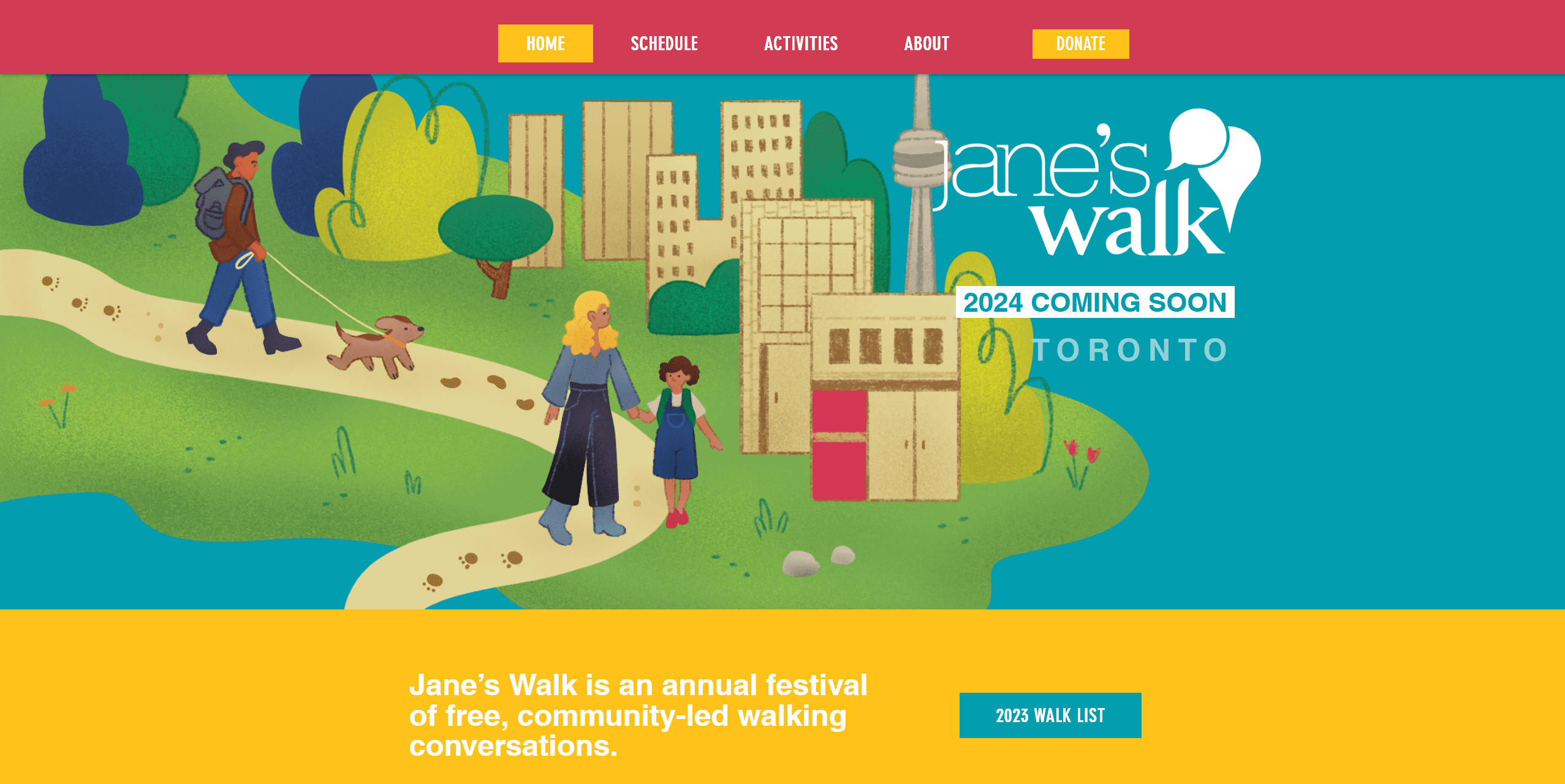TWHP members have developed several walking tours that can be presented on request and/or customized for specific groups or focused on specific areas of social justice. Contact info@twhp.ca.
Facilitated by: J.P. Hornick, Maureen Hynes, and Sue Smith
- Contemporary and Historical Struggles for Safe and Equitable Work
(Developed with the Injured Workers Community Legal Clinic).
Focusing on sites on and around University Avenue, this labour history walking tour focuses on both historical and current labour issues and activism in Toronto. It highlights the struggles, gains and losses of Ontario workers in seeking safe, fair and equitable working conditions – and how workers’ activism has shaped the province’s employment legislation.
- Women, Work, and Resistance: A Modern Tale of Love and Labour
This tour, developed in collaboration with the Workers’ Action Centre, covers modern labour activism (the 1960’s up to the present) and highlights the struggles, victories and losses of immigrant women—from live-in caregivers to garment workers to temp workers to cleaners—in seeking just and equitable working conditions. It examines the connections between that activism and employment legislation.
- Spadina Avenue: Seven Generations of Immigrant Women’s Work
This tour highlights how Toronto’s immigrant women have shaped the labour and feminist movements from the 1850’s up to the present – a history that has been silenced and marginalized. We bring back to life vibrant and committed women union leaders like Grace Hartman and Madeleine Parent; international figures like Emma Goldman and lesser-known Toronto women like Lil Ilomaki, a Depression-era union organizer. We learn about how these women’s activism enriched the arts, helped create the seeds of our public services, our social safety net and the province’s educational system.
- Toronto’s Old Town
Explore the oldest section of Toronto, our “Old Town,” with its vibrant and turbulent past. This walk honours the earliest sites of aboriginal Toronto, charts waves of immigration that have left marks on our Old Town, and uncovers hidden moments in labour history. Learn about the texture of daily life from the 1830s onward, uprisings and hangings and the massive demonstrations of the 1870s to support workers when unions were illegal – as well as an infamous site of the current “imperious clout of corporate Canada.”
- The Ward, Spadina Avenue, and Chinatown
Toronto’s Jewish community moved westward from “The Ward” in the 1910s, 20s and 30s to Spadina Avenue, taking with them a thriving garment industry and its militant union organizing. We’ll visit the sites of significant cultural and labour organizations, including the Labor Lyceum, and theatres where Toronto’s “Red Squad” closed down Communist productions. As the Jewish community moved northward, Chinese immigrants moved in, but Spadina for several decades the area remained a vibrant centre of the garment industry. It is to this day an important immigrant gateway area in the city, and it takes in the wonderful Kensington Market.
- The Ward
St. John’s Ward, now razed and re-developed into Toronto’s City Hall, hospitals and
office towers, was an impoverished but vital community to waves of Irish, African-American, Italian, eastern European Jews and Chinese immigrants and refugees. The massive factory of the T. Eaton Company – an employer who sparked some of the city’s most famous strikes – dominated its landscape, as did the House of Industry, the city’s “poorhouse.” We highlight activists like Jean Lumb, who worked to gain legal status for Chinese immigrants; women who lobbied for clinics, playgrounds and schools; and sex workers who carved out a space for themselves within the “bachelor society” of Chinatown.
Facilitated by David Kidd
- Downtown West Activist Tour (Beverley – University, College to Baldwin)
The walk highlights the significant buildings and locations of events and struggles over a century from a variety of eras from the 1870s to the 1970s and the activists involved from Donald Moore to Louis Cameron and from Norman Bethune to Grace Hartman
- Downtown East Toronto Introductory History Tour (Church to Sherbourne, Carlton to Shuter)
The walk starts across the street from Maple Leaf Gardens (MLG), highlighting the progressive political meetings that took place at MLG and then heads down Church St. to review key moments in the struggles of the Gay community, such as the Bath Raids and the HIV crisis. It then heads through the grounds of Ryerson University, reviewing Egerton Ryerson’s role and then heads south to the St. Michael’s Cathedral, highlighting the early history of Irish immigration to Toronto. Heading east, the original Toronto Labour Council building is noted and the history thereof, and then the walk winds it way by the Mutual St. Arena site and Seaton House and stopping in Allan’s Gardens. There the free speech fight of the 1930s and 1960s is reviewed as well as the organizing efforts of the organizations fighting homelessness in the 1980s and 1990s.
- 1872 Printers’ Strike and the Fight for the Nine Hour Day (St. Lawrence Market, King St. – Jarvis to Yonge Sts.)
The walk highlights the beginnings of industrialization and the labour movement in Toronto through the organizing of craft unions into a movement for the Nine Hour working day. Participants are taken through a part of Toronto where the buildings date from the period of history of the 1870s and reviews the significance of this history for the Toronto and the Canadian labour movement. The tour starts near the St. Lawrence Market and winds it way towards Yonge St. and to locations that are actual sites of this history.
- Spadina: From Steelworkers’ Hall to Spadina and Dundas and Workers’ History
An introduction to union history and immigration to Toronto through a walk along Spadina Ave and its rich history. The walk focuses on the organization of unions and the working conditions that garment workers faced in early industrial Toronto. The history on Spadina associated with the Jewish and Afro Canadian working class communities that immigrated to our city is also highlighted.
- The History of the Canadian Union of Postal Workers (CUPW)
The walk takes participants by downtown Toronto sites associated with CUPW’s history. It starts at Scotia Bank Arena (SBA), the site of the largest of one of CUPW workplaces in Canada, and then winds its way by a common meeting location of CUPW and then concludes at the King Edward Hotel where the original convention of union delegates approved the formation of the union.
6. The Workers’ History of the Ward
This walk highlights the history of the diverse immigrant communities that lived in the area known as The Ward and then highlights labour, unemployed and community organizing that took part in the early 1990s in the community and environs. The history of the beginnings of a number of community institutions is also reviewed. The walk covers the area bounded by Gerrard, University, and Yonge Sts. and City Hall.
- The Labour Opposes the War
The walk was developed as part of the centenary of World War I to present the united opposition of the union movement in Toronto and across Canada to conscription in the war with 2 actors playing the roles as key participants in the history. The walk begins at Church & Shuter Sts. and takes the participants along Shuter St. to discuss the mounting pressure from Toronto churches, the Canadian state, and high society to support conscription, while the labour movement stood opposed. The route stops at key locations that include rallying spots for both sides in the conscription debate and some of the fall out including the anti-Greek riots that took place along Yonge St. at war’s end. The walk looks at the massive increase of women working in munitions’ factories during the war and their conditions of work as well as the entry of labour unions into the political arena.
Craig Heron
The Workers’ History of Spadina
The walk moves south on Spadina from College to Queen, with a side trip along Cecil, highlighting the meeting halls and locations for organizing, demonstrating, shopping, drinking, praying, and enjoying music. We look at the use and reuse of several buildings and the diverse activities organized within and around them in particular by Jewish, Portuguese, and Chinese workers.

